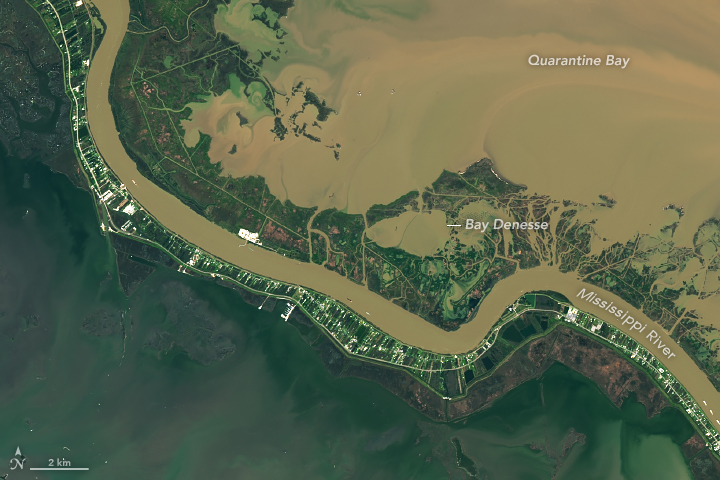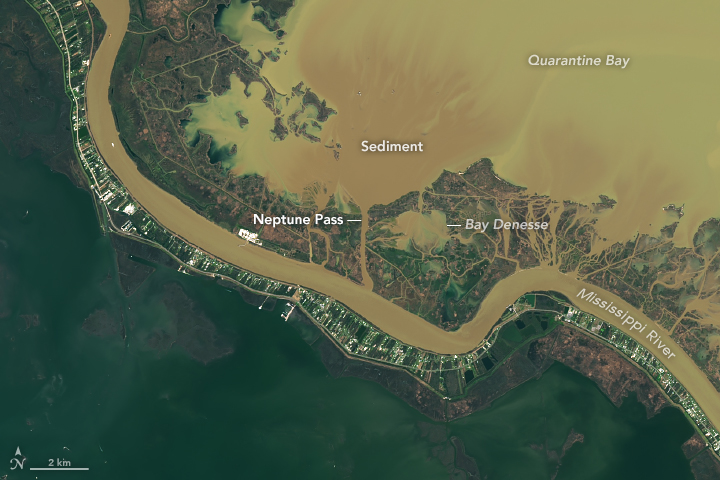

The Widening of Neptune Pass
Downloads
- neptunepass_oli_2019010_lrg.jpg (1958x1305, JPEG)
- neptunepass_oli_2023037_lrg.jpg (1958x1305, JPEG)
Metadata
- Sensor(s):
- Landsat 8 - OLI
- Data Date: January 10, 2019 - February 6, 2023
- Visualization Date: March 15, 2023
Over the past six years, what was once a small canal on the east bank of the Mississippi River has widened to become a major channel, with a flow five times that of New York’s Hudson River.
The channel, called Neptune Pass, is about 25 miles (40 kilometers) upriver from where the Mississippi empties into the deep waters of the Gulf of Mexico. The channel now delivers freshwater and sediment into the shallower coastal waters of Quarantine Bay and Bay Denesse, much closer to New Orleans.
“This is the biggest branch of the river to open up in almost a century,” said Alex Kolker, a coastal geologist at the Louisiana Universities Marine Consortium.
Neptune Pass can be seen cutting through the wetlands on the east bank of the Mississippi River in the image above (right). The image was acquired by the Operational Land Imager (OLI) on Landsat 8 on February 6, 2023. It shows a plume of sediment fanning out across Quarantine Bay, an inlet between the coast and the Gulf of Mexico. The image on the left shows the same area in 2019, before the canal widened.
Kolker noticed Neptune Pass while looking through satellite imagery in the early days of the COVID-19 pandemic. “I looked at different passes in the region, including Mardi Gras Pass and the crevasses near Fort St. Phillip,” Kolker said. “But in the middle of those two, I noticed an existing canal had significantly widened.”
What had been a 150-foot canal in 2016 had widened to become an 850-foot-wide distributary in 2023, with a flow of over 118,600 cubic feet (3,360 cubic meters) per second, about 16 percent of the Mississippi’s total flow. Kolker thinks the widening may have been a response to several years of high river flow, especially during the major flooding that occurred along the Mississippi in the spring of 2019.
On this part of the river—known as the Bohemia Spillway—the remaining levees are aging, allowing the river to break free like it has downriver of Fort St. Phillip. But this pass is much larger than many that came before. For comparison, Mardi Gras Pass—a distributary that opened up a few miles upriver a decade ago—siphons 25,000 cubic feet per second from the main channel. Kolker noted that Neptune Pass is roughly the size of the Wax Lake Outlet of the Atchafalaya River, which opened in 1941.
Kolker uses field data and Landsat data to investigate the causes of land loss and gain in the Mississippi River Delta. In 2017, Kolker and colleagues found that new river distributaries—both river-forged and human-made—that bring sediment-rich water to shallow waters, have the potential to build new wetlands in coastal Louisiana that are resilient to erosion from storms.
The recent Landsat image shows teardrop-shaped islands—known as mouth bars—in the plume of sediment coming from Neptune Pass. These are indications of the buildup of deposited sediment, Kolker noted. Tendrils of sediment and vegetation also appear to be developing in Bay Denesse. Kolker and colleagues plan to take boats to the pass in the spring of 2023 to sample the sediment and measure how much land is being built.
References & Resources
- Amer, R., Kolker, A. S., & Muscietta, A. (2017) Propensity for erosion and deposition in a deltaic wetland complex: Implications for river management and coastal restoration. Remote Sensing of Environment, 199, 39-50.
- Grist (2022, June 17) As the Louisiana coast disappears, the Mississippi River’s newest channel is building much-needed land. Accessed March 15, 2023.
- Kolker, Alex (2022) Neptune Pass: The Mississippi River’s Largest New Distributary. Accessed March 15, 2023.
- The Times-Picayune/The New Orleans Advocate (2022, June 3) ‘Power of the river’: New Mississippi River channel prompts Corps to take action. Accessed March 15, 2023.
- NASA Earth Observatory (2023, February 12) Mardi Gras Pass.
- NASA Earth Observatory (2019) Flooding in the Mississippi Watershed 2019.
- NASA Earth Observatory World of Change: Growing Deltas in Atchafalaya Bay.
NASA Earth Observatory images by Allison Nussbaum, using Landsat data from the U.S. Geological Survey. Story by Emily Cassidy.
This image record originally appeared on the Earth Observatory. Click here to view the full, original record.